The warmth of the sun's embrace is undoubtedly delightful, but it often comes with a necessary step – sunscreen application. While sunscreen shields us from the sun's harmful UV rays, its residue can sometimes leave stubborn marks on our skin, clothing, and even our cherished furniture.
While it's important to apply sunscreen for sun protection, it is also important to learn how to properly remove sunscreen from your skin, clothing, and furniture. Keep reading to learn why it's vital to remove sunscreen and how to remove it.
Why It's Important To Remove Sunscreen
Although sunscreen is crucial to protecting our skin, it also can create its own set of skin issues. These concerns are much less dire than skin cancer! But they can be very annoying, uncomfortable, and embarrassing.
Sun-derived Vitamin D accelerates the rapid reproduction of our skin cells beyond the usual rate. This is a healthy reaction to the sun! However, the sunscreen we apply to protect our skin from ultraviolet rays prevents our skin cells from shedding rapidly. This creates a perfect environment for clogged pores.
Not only will trapped skin cells themselves cause clogged pores, but sunscreen is typically applied during time outdoors. This comes with sweat, dirt, dead skin cells, and other surface-level pollutants that further clog pores.
Clogged pores lead to various blemishes, including whiteheads and blackheads. However, people with sensitive skin may deal with more painful forms of chronic acne, such as cysts.
How To Remove Sunscreen From Your Skin
Several methods exist for eliminating sunscreen residue from the skin, with the approach varying based on individual skin type and the type of sunscreen used.
There are many different types of sunscreen formulas, each featuring its distinct blend of active ingredients. The ease of removal can significantly differ among these options. Typically, chemical formulas wash off easily from the skin. While they possess a degree of water resistance, they are not entirely waterproof. Conversely, a zinc oxide mineral sunscreen can prove to be quite challenging to eliminate. Mineral sunscreens are thick and practically waterproof. A water-based cleanser will not be very effective in removing them.
Try the various ways to remove sunscreen below. Use the one that is the most effective for your type of sunscreen and the gentlest for your skin type!
Face Wash
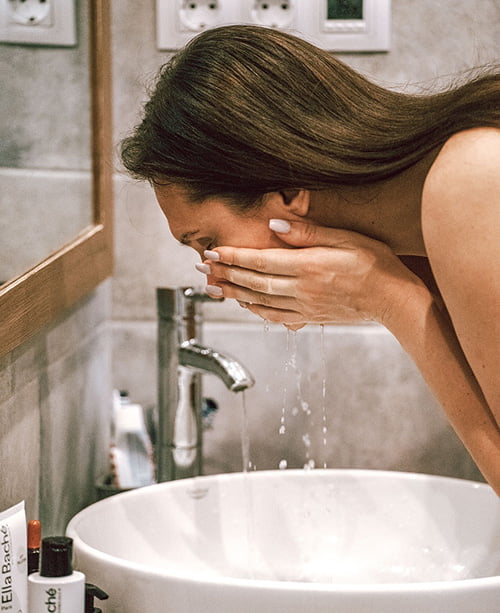
Your first step in removing sunscreen should be to try using your regular facial cleanser. Remember that you are trying to remove sunscreen, not just regular makeup or daily grime! You may need to use your facial cleanser twice to clean your skin.
Cleansing Oils
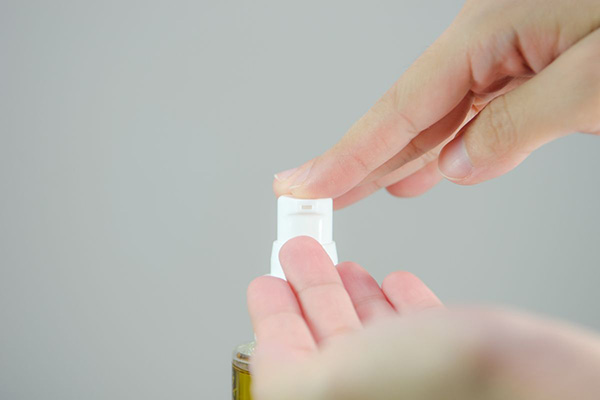
An oil-based sunscreen will be most effectively removed by using an oil-based cleaner. People with oily skin or excess oil may be hesitant to use an oil cleanser, but dermatologists have found that cleansing oil to lift oil is very gentle and gives positive results!
Nevertheless, the outcome varies based on the specific oil you choose to use. You can purchase a premade oil-based cleanser or use a single cleansing oil of your choice. Sweet almond oil, olive oil, and jojoba oil are top choices for cleaning oils. Conversely, it's advisable to steer clear of coconut oil.
To use a cleansing oil to remove an oil-soluble sunscreen, simply massage a small amount of cleansing oil into your face and allow it to soak in for a few minutes. Then, soak a towel in warm water, wring it out, and hold the damp towel over your face for 15 seconds, allowing the steam to pull the excess oil from your pores. Next, delicately wipe off the oils, effectively removing the sunscreen in the process! In addition, there are other oil-cleansing methods that you can use.
Cleansing oils are particularly effective in removing water-resistant minerals and chemical sunscreens.
Micellar Water
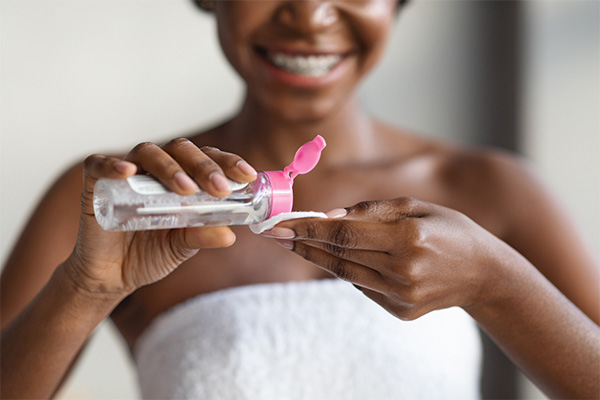
A water-based cleanser, such as micellar water or makeup remover, can easily remove chemical sunscreens from your face. These cleansers typically contain water, surfactants, and emulsifiers. They are simple to use and effectively remove sunscreen by simply wiping a cotton pad across your skin.
Double Cleansing Method
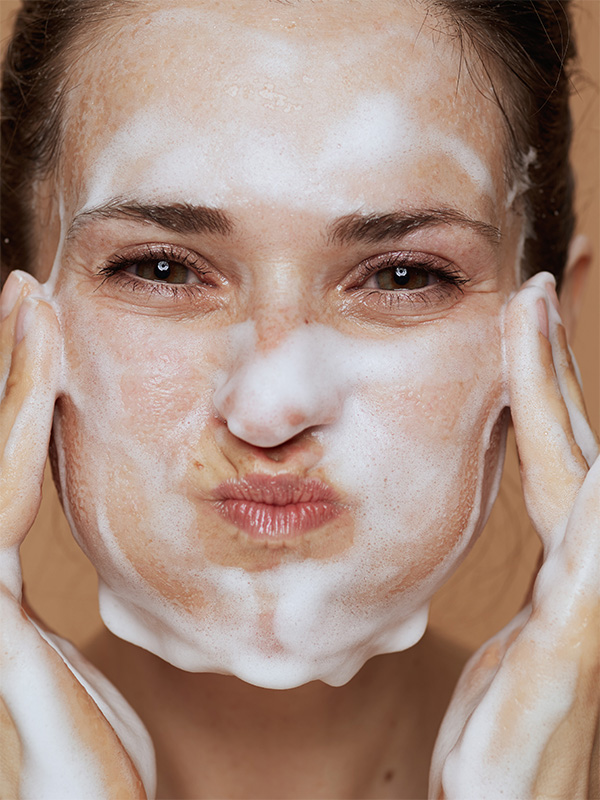
Double cleansing is a skincare technique that uses two distinct cleansers sequentially to eliminate impurities, sunscreen, makeup, and any residual build-up from your skin. It's particularly effective for individuals who wear heavy makeup, have stubborn sunscreen residue, or want to ensure a deep cleanse at the end of the day. Double cleansing can be especially beneficial when removing mineral sunscreen, which tends to have a thicker and more tenacious texture.
Here's how the double cleanse method works, specifically for removing mineral sunscreen:
- Oil-Based Cleanser. Begin by using an oil-based cleanser. Apply a generous quantity to dry skin and softly massage it using circular motions. The oil-based cleanser breaks down and dissolves sunscreen, makeup, and impurities. The oil binds to the oils in the sunscreen, making it easier to lift off your skin.
- Water-Based Cleanser. Following the removal of the oil-based cleanser, proceed with a water-based cleanser. This could be a foaming cleanser, gel cleanser, or cream cleanser. Apply the water-based cleanser onto damp skin and create a lather. Gently massage your face to cleanse your skin further and remove any remaining traces of sunscreen and makeup.
How To Remove Sunscreen Stains From Fabrics
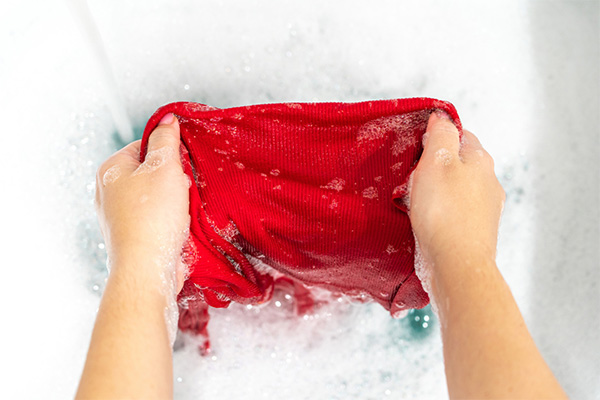
Leaving sunscreen on your skin can not only cause acne but can also stain fabrics that you come into contact with! The oily substances in some sunscreen formulas can cause grease stains. Sunscreens that contain avobenzone can leave yellow, orange, or rusty brown stains. It's important to remove sunscreen from your skin to avoid these stains! But if you do have sunscreen stains to deal with, here's what to do.
Clothing Stains
- Blot the Stain: At the earliest sight of the sunscreen stain, use a clean white cloth or paper towel to blot the area and gently eliminate any surplus sunscreen. Refrain from rubbing, which could embed the stain further into the fabric.
- Pre-Treat the Stain: Put a small quantity of dishwashing liquid or laundry detergent directly onto the stain. Gently rub the fabric together to incorporate the detergent. Alternatively, you can utilize a commercial stain remover or pre-treatment product following the instructions provided. If you are using an oil-based sunscreen, sprinkle baking soda or cornstarch on the sunscreen stain and let it sit for 15 to 30 minutes. It will absorb excess oils.
- Rinse with Cold Water: Place the stained area under cold running water to thoroughly rinse out as much sunscreen as possible. Blot the area with a clean cloth or paper towel throughout the process.
- Enzyme-Based Stain Remover (Optional): If the stain persists, consider using an enzyme-based laundry stain remover. Follow the product's instructions for application.
- Baking Soda (For Older Stains): Mix a paste of baking soda and cold water for older or set sunscreen stains. Spread the paste over the stain, gently scrub the area, and allow it to sit for approximately 15 minutes before rinsing.
- Rubbing Alcohol (For Oily or Greasy Sunscreens): If the sunscreen stain is oily or greasy, put a small quantity of rubbing alcohol onto a clean cloth and gently blot the affected area. Rinse with cold water afterward.
- Wash as Usual: Wash the fabric as usual in cold water, following the care instructions on the fabric's label. Refrain from using hot water, as heat has the potential to set the stain.
- Check Before Drying: Before drying the fabric, ensure the stain has been entirely eliminated. The heat from the dryer can cause any residual stain to set, complicating its removal in the future.
Bonus Tip: If your stained clothing is white, spray it with lemon juice! Lemon juice, when combined with sunlight, is a natural bleaching agent! After washing your stained clothes, apply lemon juice and then hang the item outside in the sun to dry.
How To Remove Sunscreen Stains From Furniture

Effectively addressing sunscreen stains on furniture necessitates cautious attention to avoid exacerbating the damage.
When dealing with fabric-covered furniture, begin by scraping up any excess sunscreen. Gently blot the sunscreen stain using a white cloth or paper towel. Next, create a solution by mixing mild dish soap or laundry detergent with water. Use about one teaspoon of soap or detergent with one cup of water. Moisten a fresh white cloth with the cleaning solution.
Blot the sunscreen stain gently with the damp cloth. Persistently blot until you observe the stain starting to lift. Then, dampen another clean cloth with water and gently blot the area to eliminate any lingering soap residue. Once completed, permit the fabric to air dry naturally. Avoid using a hair dryer or heat source, which can set the stain.
For leather furniture, the cleaning solution should only consist of water and white vinegar or mild leather cleaner. Dip a cloth into this solution and use it to wipe the leather. Gently blot the sunscreen stain using a damp cloth, taking care not to saturate the leather. Dampen another clean cloth with water and blot the area to remove any residue from the cleaning solution. Gently pat the cleaned area with a dry cloth to remove excess moisture. Allow the leather to air dry naturally.

